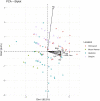Seed Composition and Amino Acid Profiles for Quinoa Grown in Washington State
- PMID: 32903386
- PMCID: PMC7434868
- DOI: 10.3389/fnut.2020.00126
Seed Composition and Amino Acid Profiles for Quinoa Grown in Washington State
Erratum in
-
Corrigendum: Seed Composition and Amino Acid Profiles for Quinoa Grown in Washington State.Front Nutr. 2020 Nov 9;7:605674. doi: 10.3389/fnut.2020.605674. eCollection 2020. Front Nutr. 2020. PMID: 33240922 Free PMC article.
Abstract
Quinoa (Chenopodium quinoa Willd.) is a pseudocereal celebrated for its excellent nutritional quality and potential to improve global food security, especially in marginal environments. However, minimal information is available on how genotype influences seed composition, and thus, nutritional quality. This study aimed to provide a baseline for nutritional quality of Washington grown quinoa and test the hypothesis that these samples contain adequate amounts of essential amino acids to meet daily requirements set by the World Health Organization (WHO). One hundred samples, representing commercial varieties and advanced breeding lines adapted to Washington State, were analyzed for content of 23 amino acids, as well as crude protein, ash, moisture, and crude fat. Mean essential amino acid values for Washington grown quinoa met the daily requirements for all age groups for all essential amino acids, except for the amount of leucine required by infants. We found that only nine genotypes met the leucine requirements for all age groups. A total of 52 and 94 samples met the lysine and tryptophan requirements for all age groups, respectively. Mean values for isoleucine, leucine, lysine, tryptophan, valine, and the sulfur and aromatic amino acids are higher for Washington grown samples than those reported previously reported in the literature. Our results show that not all Washington grown quinoa samples meet daily requirements of essential amino acids, and we identify limiting amino acids for the germplasm and environments investigated. This study provides the first report of leucine as a limiting amino acid in quinoa. Additional research is needed to better understand variation in quinoa nutritional composition, identify varieties that meet daily requirements, and explore how genotype, environment, and management interactions influence nutritional quality.
Keywords: complete protein; essential amino acid; limiting; protein quality; quinoa.
Copyright © 2020 Craine and Murphy.
Figures


Similar articles
-
Quinoa in Ecuador: Recent Advances under Global Expansion.Plants (Basel). 2021 Feb 4;10(2):298. doi: 10.3390/plants10020298. Plants (Basel). 2021. PMID: 33557315 Free PMC article. Review.
-
A comprehensive characterization of agronomic and end-use quality phenotypes across a quinoa world core collection.Front Plant Sci. 2023 Feb 16;14:1101547. doi: 10.3389/fpls.2023.1101547. eCollection 2023. Front Plant Sci. 2023. PMID: 36875583 Free PMC article.
-
A comparative analysis of the nutrient and phytochemical richness among different varieties of quinoa in China.Food Sci Nutr. 2024 Apr 24;12(6):4473-4485. doi: 10.1002/fsn3.4113. eCollection 2024 Jun. Food Sci Nutr. 2024. PMID: 38873460 Free PMC article.
-
Nutritional quality of the protein in quinoa (Chenopodium quinoa, Willd) seeds.Plant Foods Hum Nutr. 1992 Jan;42(1):1-11. doi: 10.1007/BF02196067. Plant Foods Hum Nutr. 1992. PMID: 1546052
-
Quinoa (Chenopodium quinoa Willd.): composition, chemistry, nutritional, and functional properties.Adv Food Nutr Res. 2009;58:1-31. doi: 10.1016/S1043-4526(09)58001-1. Adv Food Nutr Res. 2009. PMID: 19878856 Review.
Cited by
-
Development of Functional Gluten-Free Sourdough Bread with Pseudocereals and Enriched with Moringa oleifera.Foods. 2023 Oct 26;12(21):3920. doi: 10.3390/foods12213920. Foods. 2023. PMID: 37959040 Free PMC article.
-
Box-Behnken Design: Wet Process Optimization for Saponins Removal From Chenopodium quinoa Seeds and the Study of Its Effect on Nutritional Properties.Front Nutr. 2022 Jul 1;9:906592. doi: 10.3389/fnut.2022.906592. eCollection 2022. Front Nutr. 2022. PMID: 35845775 Free PMC article.
-
Identification of Reference Genes for Precise Expression Analysis during Germination in Chenopodium quinoa Seeds under Salt Stress.Int J Mol Sci. 2023 Nov 1;24(21):15878. doi: 10.3390/ijms242115878. Int J Mol Sci. 2023. PMID: 37958860 Free PMC article.
-
Quinoa in Ecuador: Recent Advances under Global Expansion.Plants (Basel). 2021 Feb 4;10(2):298. doi: 10.3390/plants10020298. Plants (Basel). 2021. PMID: 33557315 Free PMC article. Review.
-
Effect of Germination on the Physicochemical Properties, Functional Groups, Content of Bioactive Compounds, and Antioxidant Capacity of Different Varieties of Quinoa (Chenopodium quinoa Willd.) Grown in the High Andean Zone of Peru.Foods. 2024 Jan 27;13(3):417. doi: 10.3390/foods13030417. Foods. 2024. PMID: 38338552 Free PMC article.
References
-
- FAO, CIRAD State of the Art Report on Quinoa Around the World in 2013, Bazile D, Bertero D, Nieto C, editors (2015). Available online at: https://www.researchgate.net/publication/273134308
-
- Simmonds NW. The breeding system of Chenopodium quinoa I. Male Steril Heredity. (1971) 27:73–82. 10.1038/hdy.1971.72 - DOI
LinkOut - more resources
Full Text Sources
Research Materials
Miscellaneous

